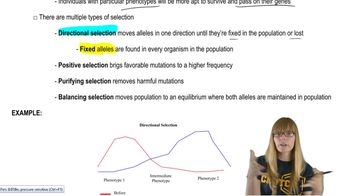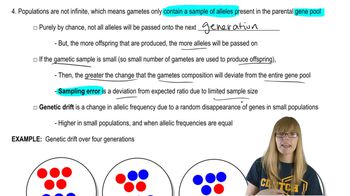Table of contents
- 1. Introduction to Genetics51m
- 2. Mendel's Laws of Inheritance3h 37m
- 3. Extensions to Mendelian Inheritance2h 41m
- 4. Genetic Mapping and Linkage2h 28m
- 5. Genetics of Bacteria and Viruses1h 21m
- 6. Chromosomal Variation1h 48m
- 7. DNA and Chromosome Structure56m
- 8. DNA Replication1h 10m
- 9. Mitosis and Meiosis1h 34m
- 10. Transcription1h 0m
- 11. Translation58m
- 12. Gene Regulation in Prokaryotes1h 19m
- 13. Gene Regulation in Eukaryotes44m
- 14. Genetic Control of Development44m
- 15. Genomes and Genomics1h 50m
- 16. Transposable Elements47m
- 17. Mutation, Repair, and Recombination1h 6m
- 18. Molecular Genetic Tools19m
- 19. Cancer Genetics29m
- 20. Quantitative Genetics1h 26m
- 21. Population Genetics50m
- 22. Evolutionary Genetics29m
21. Population Genetics
Allelic Frequency Changes
Problem 22c
Textbook Question
Tay–Sachs disease is an autosomal recessive neurological disorder that is fatal in infancy. Despite its invariably lethal effect, Tay–Sachs disease occurs at very high frequency in some Central and Eastern European (Ashkenazi) Jewish populations. In certain Ashkenazi populations, 1 in 750 infants has Tay–Sachs disease. Population biologists believe the high frequency is a consequence of genetic bottlenecks caused by pogroms (genocide) that have reduced the population multiple times in the past several hundred years. Explain how a genetic bottleneck and its aftermath could result in a population that carries a lethal allele in high frequency.
 Verified step by step guidance
Verified step by step guidance1
Understand the concept of a genetic bottleneck: A genetic bottleneck occurs when a population's size is significantly reduced for at least one generation, leading to a loss of genetic diversity.
Recognize the impact of a genetic bottleneck: When a population undergoes a bottleneck, the genetic variation is reduced, and certain alleles may become more common purely by chance.
Consider the role of genetic drift: In small populations, genetic drift can have a strong effect, causing certain alleles, including deleterious ones, to increase in frequency.
Apply this to Tay–Sachs disease: In the case of the Ashkenazi Jewish population, repeated bottlenecks due to historical events like pogroms could have led to an increase in the frequency of the Tay–Sachs allele.
Understand the aftermath: After the bottleneck, the population may grow again, but the allele frequencies established during the bottleneck can persist, leading to a high frequency of the Tay–Sachs allele in the population.
Recommended similar problem, with video answer:
 Verified Solution
Verified SolutionThis video solution was recommended by our tutors as helpful for the problem above
Video duration:
1mPlay a video:
Was this helpful?
Key Concepts
Here are the essential concepts you must grasp in order to answer the question correctly.
Genetic Bottleneck
A genetic bottleneck occurs when a population experiences a significant reduction in size due to environmental events or human activities, leading to a loss of genetic diversity. This reduction can result in certain alleles becoming more prevalent simply due to chance, as the surviving population may not represent the genetic diversity of the original group. Consequently, alleles that may be harmful, such as those causing Tay–Sachs disease, can become more common in the population.
Recommended video:
Guided course

Descriptive Genetics
Autosomal Recessive Inheritance
Autosomal recessive inheritance refers to a pattern where two copies of a mutated gene (one from each parent) are necessary for an individual to express a trait or disorder. In the case of Tay–Sachs disease, individuals must inherit two copies of the defective gene to develop the condition, while carriers with only one copy remain unaffected. This mode of inheritance can lead to a higher frequency of the allele in populations where carriers are more common due to historical factors like genetic bottlenecks.
Recommended video:
Guided course

Autosomal Pedigrees
Founder Effect
The founder effect is a phenomenon that occurs when a small group of individuals establishes a new population, leading to a limited genetic variation compared to the original population. If the founders carry certain alleles, including those for genetic disorders, these alleles can become disproportionately represented in the new population. In the context of Tay–Sachs disease, the historical isolation and demographic events affecting Ashkenazi Jews may have contributed to a higher frequency of the lethal allele due to the founder effect.
Recommended video:
Guided course

Maternal Effect

 5:58m
5:58mWatch next
Master Natural Selection with a bite sized video explanation from Kylia Goodner
Start learning




